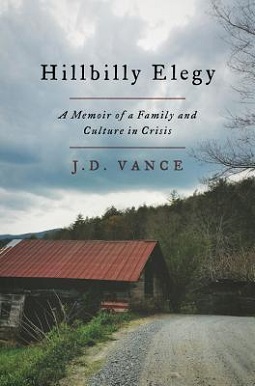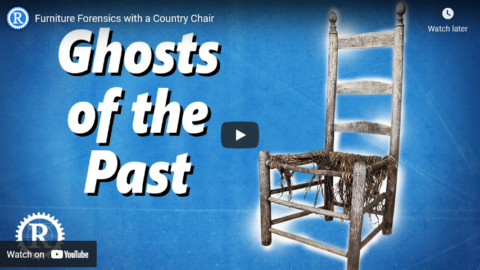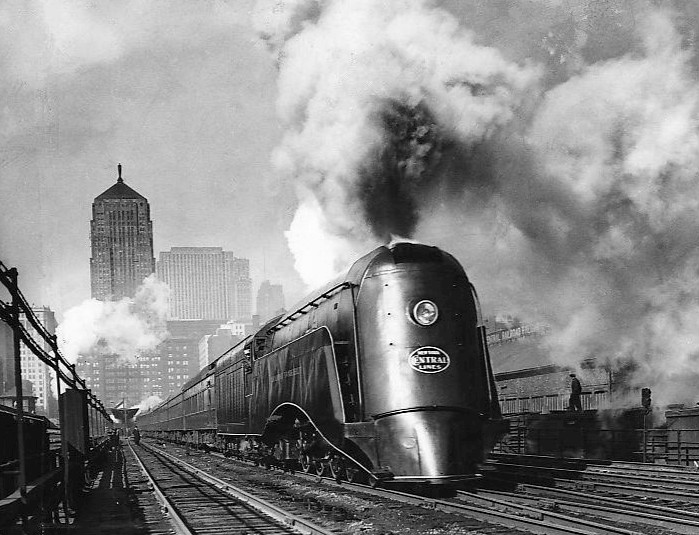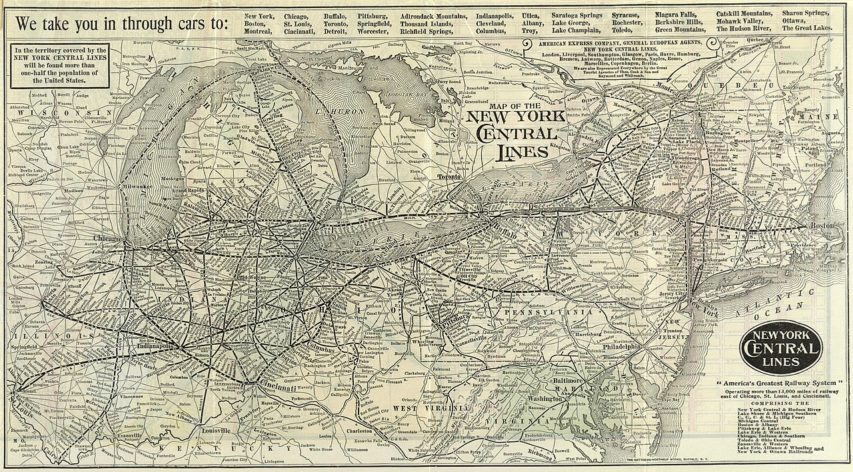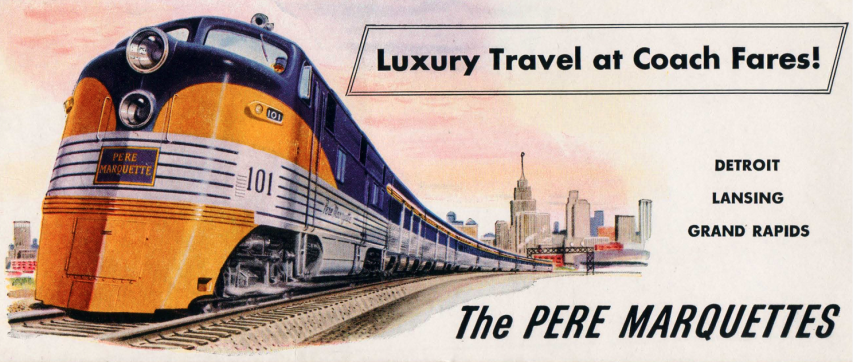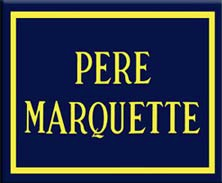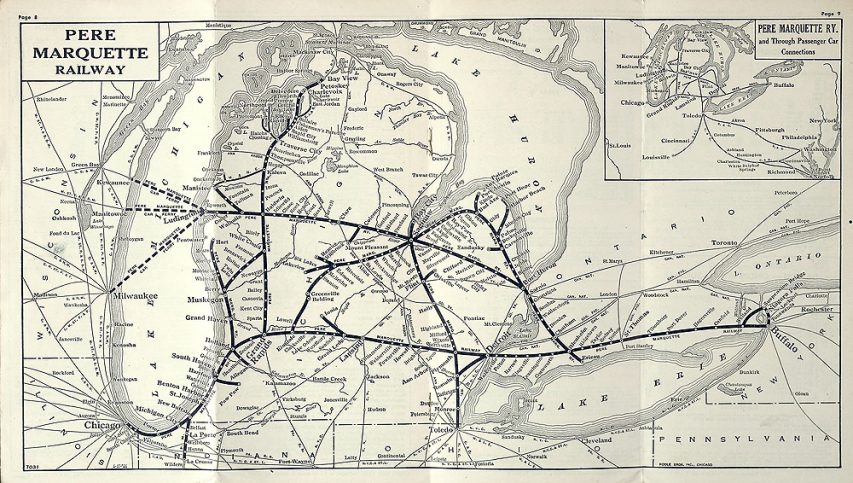Rex Krueger
Published 13 Feb 2025
(more…)
February 15, 2025
Vintage Workbenches: Quick, Dirty, and Awesome
November 20, 2024
What on earth is a Buck Board Bench?
Rex Krueger
Published Jul 25, 2024Furniture Forensics returns thanks to the mysterious Buck Board bench.
(more…)
July 17, 2024
Trump selects J.D. Vance as his 2024 running mate
Presumptive Republican presidential candidate and former President Donald Trump announced that he has chosen US Senator J.D. Vance of Ohio as his running mate in the 2024 election:

U.S. Senator J.D. Vance speaking with attendees at The People’s Convention at Huntington Place in Detroit, Michigan, 16 June, 2024.
Detail of a photo by Gage Skidmore via Wikimedia Commons.
Donald Trump’s selection of J.D. Vance as his running mate is remarkable in more ways than one. There is Vance’s journey from the broken home in a poor, rural Ohio he wrote about in Hillbilly Elegy, to the Marines, to Ohio State, then to Yale Law School and to the Senate, and now a presidential ticket. Also remarkable is his transformation from a prominent “Never Trumper” — who once called his now – running mate “America’s Hitler” and an “opioid for the masses” — to an enthusiastic Trumpist in the vanguard of the New Right.
For some, Vance’s journey is simple enough to explain: it’s the story of a smart and ambitious “sellout” and an “angry jerk”, as one of his (ex-) friends from law school put it on X yesterday. To this crowd, Vance is only the most extreme example of a familiar story of Republicans kowtowing to the man who took over their party.
But Vance is a much more complicated — and interesting — figure than that.
Agree with him or not, he has undergone a sincere ideological conversion since 2016. That much was obvious to me when I followed him on the campaign trail in 2022. And it’s obvious from any speech or interview he gives. He is not someone who just parrots his party’s talking points. (He has also undergone an actual conversion: I recommend Rod Dreher’s interview with him on the day he was baptized and received into the Catholic Church in 2019.)
In the Senate, he hasn’t just voted with the GOP herd but teamed up with Democrats on a range of bills that stake out new ideological territory for Republicans. He makes some of Trump’s donors uncomfortable.
By picking Vance, Trump has made clear his project is about more than personality. The Republican presidential ticket now has a distinct ideological flavor. It has teeth. National Review‘s Philip Klein called the pick “another nail in the coffin of Reagan Republicanism”. (This is not a compliment at that magazine.) Vance is a prominent critic of U.S. involvement in Ukraine (for more on his foreign policy views, I recommend this piece by my colleague Isaac Grafstein).
He’s also economically unorthodox — and more relaxed about government involvement in the economy than many of his colleagues. He has backed a higher minimum wage and praised Lina Khan, Joe Biden’s FTC chair and a proponent of more robust antitrust policies.
Did these ideological considerations clinch it for Vance? I suspect a bigger factor was that in Vance, Trump saw someone who was welcomed into the elite — as Trump never has been — but who turned his back on it.
Before the VP nomination, before entering the political arena, Vance was known for his memoir about growing up poor in rural Ohio, Hillbilly Elegy. Helen Dale reviewed the book when it came out and had this to say about it and the author:
Hillbilly Elegy is an extended meditation on cultural and social capital. It asks seriously — and answers truthfully — this question: “what makes the upper-middle classes different?”
J.D. Vance (“Jaydot” to his friends) has written the best book about class by an American. It explains everything from the rise of Donald Trump to Leave’s win in the Brexit Referendum to One Nation claiming four Australian Senate seats. In answering the above question, Vance has also performed an inestimably valuable service to those of us engaged in public policy and political commentary: reading his book will teach you the folly of making rules — as my father often said when I was a child — “for people not like you”.
Vance is an Appalachian hillbilly, but also a graduate of Yale Law School. His “white trash” upbringing was as dysfunctional as that of many children in remote Australian Aboriginal communities or the slums of Glasgow: drug addiction, domestic violence, alcoholism, a revolving door of more or less useless father figures. His foul-mouthed, Tony Soprano-like grandmother (called Mamaw, pronounced ma’am-aw) saved him from the gutter and kept him looking at the stars, using any and every means possible.
Her husband, Vance’s Papaw, was a drunk. Mamaw warned Papaw that if he ever came home drunk again, she’d kill him. He did, so she doused him with kerosene and set him on fire. Fortunately, Papaw didn’t die. He did, however, give up the bottle, and in time became a model of decent, humane masculinity.
Like many of his Scots-Irish kin, Vance joined the Marines, grateful not only for the GI Bill (which funded his time at Ohio State), but also because more senior Marines and recruiters did things like show him how to balance a chequebook while steering him away from taking out a whopping 21 per cent loan for his first car. The Marines also taught him how to eat healthily (breaking an addiction to refined sugars) and helped him lose 45 pounds.
His description of a toffee-nosed law firm recruitment dinner at Yale — where he had to ask his upper-middle-class girlfriend (he called her secretly, while hiding in the loo) how place settings work (“What do I do with all these damned forks?”) — should be savoured as one of literature’s great comic scenes.
His personal story aside, Hillbilly Elegy also discloses the extent to which Vance’s people — the “poor whites” now forming the bulk of Donald Trump’s base — are not like the people who have spent fifty years making rules for them.
Vance is careful to avoid playing the Oppression Olympics common among spokespeople for disadvantaged minorities. He makes it clear his mother — who, by the end, collapses in a sleazy, spider-infested roadside motel with a needle in her arm — can only use entrenched adversity to get a moral get-out-of-jail-free card for so long. He views other hard-up hillbillies — in his own family and outside it — with the same unsentimental eye. At some point, the excuses have to stop.
June 23, 2024
The Original Chef Boyardee Spaghetti Dinner
Tasting History with Max Miller
Published 13 Mar 2024Absolutely fantastic tomato and meat sauce served over spaghetti tossed with butter and parmesan
City/Region: Cleveland, Ohio
Time Period: 1930sChef Boyardee was not born in Cleveland (sorry, 30 Rock), but in Borganovo, just outside of Piacenza in Italy. And his name was not Hector Boyardee, but Ettore Boiardi (boy-AR-dee). He opened an Italian restaurant in Cleveland in 1924, where the food was so popular that he frequently sent patrons home with bottles of his spaghetti sauce.
We can’t know exactly what that original sauce was, but this is from a family recipe and is probably pretty close. And it’s phenomenal. It’s fairly simple, but so good. You get a lot of the fresh basil, and the creaminess from mixing the butter and parmesan directly with the pasta is delicious. I don’t often make dishes from the show again, but I can see myself making this any day of the week.
(more…)
February 25, 2023
Buttigieg isn’t covering himself in glory over his belated East Palestine train derailment response
Jim Treacher is clearly trying to at least pretend some sympathy for Transportation Secretary Pete Buttigieg, but it’s a tough assignment:
Pete Buttigieg is the type of guy who walks into a job interview and says his biggest weakness is his perfectionism. As a kid he always had an apple for the teacher, and if she forgot to assign homework that day, he was the first with his hand up. He’s a repulsive little hall monitor, so all the other repulsive little hall monitors think he’s simply divine.
Mayor Pete and his fan club are having a really bad time right now, because for once he’s expected to actually do something. Producing results simply isn’t his specialty. After spending three weeks hoping the East Palestine, Ohio rail disaster would stop bothering him if he just ignored it, he finally showed up there yesterday.
And I’m starting to understand his reluctance:
What a visual, huh? He looks like a little kid playing Bob the Builder. It’s not quite Dukakis in the tank, but it’s close.
And then it got worse: He started talking.
He’s just so gosh-darn dedicated to his job, you see. His only mistake was listening to you people. He followed the norm. This is your fault!
And then he blurted out this instant classic:
Now, which of those words should you try to avoid when you’re talking about a disastrous train derailment? I’m starting to suspect this guy isn’t the unparalleled megagenius the libs keep telling us he is.
[…]
Team Pete is more concerned about reporters asking about East Palestine than about the disaster itself. The rest of us are just an abstraction to them. If they accidentally manage to help some of us, that’s fine. If not, that’s also fine. Either way, we cannot be allowed to stand in the way of their political aspirations.
Mayor Pete really did think this gig would be a cinch, didn’t he? Like, he could just do all the reading the night before the final and ace it. He’s positively resentful at being expected to do what we’re paying him to do. He thinks he’s too good for this job, which is why he’s very bad at this job.
Will Buttigieg’s tenure as transportation secretary ruin his presidential prospects? After all, that’s what this is all about for him. Maybe, maybe not. It’s not as if politics is about solving problems. All you have to do is claim you solved the problems, and your team will cheer for you no matter what.
September 9, 2021
Furniture Forensics with a Country Chair
Rex Krueger
Published 8 Sep 2021This post-and-rung chair looks like trash, but it’s actually a master-class in green woodwork.
More video and exclusive content: http://www.patreon.com/rexkrueger
See More About Traditional Furniture!: (Scroll Down)Furniture Forensics with a 19th Century Table
Video: https://youtu.be/eLBWSCuzh5QLearn Woodworking by Studying Vintage Furniture
Video: https://youtu.be/d-HB0ZIN_ZoCan you build real furniture with softwood?
Video: https://youtu.be/LW-GtrouKh8———————————————————————-
Build Your Own Furniture!
Build a Mission Bench with Simple Nailed Joinery
Video: https://youtu.be/wy7OR0kXZlc
Get the Plans: https://www.rexkrueger.com/store/xyg2…Simple Table with Hand-Cut Joinery
Part 1: https://youtu.be/EeGtuJCSv6E
Part 2: https://youtu.be/TY-twrQh0Rs
Plans: https://www.rexkrueger.com/store/plan…Make a traditional milking stool. Limited tools. No Bench.
Video: https://youtu.be/vO6lATthAmEThe LEGENDARY Six-Board Chest
Video: https://youtu.be/cBq5DGOChgc
Plans: https://www.rexkrueger.com/store/plan…Early American Cupboard Build
Playlist: https://youtube.com/playlist?list=PLR…
Plans: https://www.rexkrueger.com/store/earl…———————————————————————-
Get My New Book, Everyday Woodworking: https://amzn.to/3uQtdQr
Check out my new site: https://woodworkforhumans.com
———————————————————————-
Sign up for Fabrication First, my FREE newsletter: http://eepurl.com/gRhEVT?
———————————————————————-
Wood Work for Humans Tool List (affiliate):
*Cutting*
Gyokucho Ryoba Saw: https://amzn.to/2Z5Wmda
Dewalt Panel Saw: https://amzn.to/2HJqGmO
Suizan Dozuki Handsaw: https://amzn.to/3abRyXB
(Winner of the affordable dovetail-saw shootout.)
Spear and Jackson Tenon Saw: https://amzn.to/2zykhs6
(Needs tune-up to work well.)
Crown Tenon Saw: https://amzn.to/3l89Dut
(Works out of the box)
Carving Knife: https://amzn.to/2DkbsnM
Narex True Imperial Chisels: https://amzn.to/2EX4xls
(My favorite affordable new chisels.)
Blue-Handled Marples Chisels: https://amzn.to/2tVJARY
(I use these to make the DIY specialty planes, but I also like them for general work.)*Sharpening*
Honing Guide: https://amzn.to/2TaJEZM
Norton Coarse/Fine Oil Stone: https://amzn.to/36seh2m
Natural Arkansas Fine Oil Stone: https://amzn.to/3irDQmq
Green buffing compound: https://amzn.to/2XuUBE2*Marking and Measuring*
Stockman Knife: https://amzn.to/2Pp4bWP
(For marking and the built-in awl).
Speed Square: https://amzn.to/3gSi6jK
Stanley Marking Knife: https://amzn.to/2Ewrxo3
(Excellent, inexpensive marking knife.)
Blue Kreg measuring jig: https://amzn.to/2QTnKYd
Round-head Protractor: https://amzn.to/37fJ6oz*Drilling*
Forstner Bits: https://amzn.to/3jpBgPl
Spade Bits: https://amzn.to/2U5kvML*Work-Holding*
Orange F Clamps: https://amzn.to/2u3tp4X
Screw Clamp: https://amzn.to/3gCa5i8Get my woodturning book: http://www.rexkrueger.com/book
Follow me on Instagram: @rexkrueger
January 7, 2021
Fallen Flag — the New York Central System
 This month’s Classic Trains fallen flag feature is the first part of the history of the New York Central System by George Drury. The New York Central was one of the biggest and most economically powerful American railways for over a century before the postwar boom turned into the economic disaster of the 1960s and 70s, as passengers switched from rail to road and plane and the decline of northeastern heavy industry and mining hit the established eastern railroads very hard:
This month’s Classic Trains fallen flag feature is the first part of the history of the New York Central System by George Drury. The New York Central was one of the biggest and most economically powerful American railways for over a century before the postwar boom turned into the economic disaster of the 1960s and 70s, as passengers switched from rail to road and plane and the decline of northeastern heavy industry and mining hit the established eastern railroads very hard:
The New York Central was a large railroad, and it had several subsidiaries whose identity remained strong, not so much in cars and locomotives carrying the old name but in local loyalties: If you lived in Detroit, you rode to Chicago on the Michigan Central, not the New York Central; through the Conrail era and even now, the line across Massachusetts is still known as “the Boston & Albany.”
The streamlined steam locomotive New York Central Hudson No.5344 “Commodore Vanderbilt”, leaving Chicago’s LaSalle Street station pulling the NYC’s premier passenger traing, the 20th Century Limited, 22 February 1935.
Photo originally copyrighted International News Photos (copyright not renewed) via Wikimedia CommonsThe system’s history is easier to digest in small pieces: first New York Central followed by its two major leased lines, Boston & Albany and Toledo & Ohio Central; then Michigan Central and Big Four (Cleveland, Cincinnati, Chicago & St. Louis). By the mid-1960s NYC owned 99.8 percent of the stock of Michigan Central and more than 97 percent of the stock of the Big Four. NYC leased both on Feb. 1, 1930, but they remained separate companies to avoid the complexities of merger.
In broad geographic terms, the NYC proper was everything east of Buffalo plus a line from Buffalo through Cleveland and Toledo to Chicago (the former Lake Shore & Michigan Southern). NYC included the Ohio Central Lines (Toledo through Columbus to and beyond Charleston, W.Va.) and the Boston & Albany (neatly defined by its name). The Michigan Central was a Buffalo–Detroit–Chicago line and everything in Michigan north of that. The Big Four was everything south of NYC’s Cleveland–Toledo–Chicago line other than the Ohio Central.
The New York Central System included several controlled railroads that did not accompany NYC into the Penn Central merger. The most important of these were (with the proportion of NYC ownership in the mid-1960s):
- Pittsburgh & Lake Erie (80 percent)
- Indiana Harbor Belt (NYC, 30 percent; Michigan Central, 30 percent; Chicago & North Western, 20 percent; and Milwaukee Road, 20 percent)
- Toronto, Hamilton & Buffalo (NYC, 37 percent; MC, 22 percent; Canada Southern, 14 percent; and Canadian Pacific, 27 percent).
[…]
The New York & Harlem Railroad was incorporated in 1831 to build a line in Manhattan from 23rd Street north to 129th Street between Third and Eighth avenues (the railroad chose to follow Fourth Avenue). At first the railroad was primarily a horsecar system, but in 1840 the road’s charter was amended to allow it to build north toward Albany. In 1844 the rails reached White Plains and in January 1852 the New York & Harlem made connection with the Western Railroad (later Boston & Albany) at Chatham, N.Y., creating a New York–Albany rail route.
The towns along the Hudson River felt no need of a railroad, except during the winter when ice prevented navigation. Poughkeepsie interests organized the Hudson River Railroad in 1847. The railroad opened from a terminal on Manhattan’s west side all the way to East Albany. By then the road had leased the Troy & Greenbush, gaining access to a bridge over the Hudson at Troy. (A bridge at Albany was completed in 1866.)
By 1863 Cornelius Vanderbilt controlled the New York & Harlem and had a substantial interest in the Hudson River Railroad. In 1867 he obtained control of the New York Central, consolidating it with the Hudson River in 1869 to form the New York Central & Hudson River Railroad.
Vanderbilt wanted to build a magnificent terminal for the NYC&HR in New York. He chose as its site the corner of 42nd Street and Fourth Avenue on the New York & Harlem, the southerly limit of steam locomotive operation in Manhattan. Construction of Grand Central Depot began in 1869. The new depot was actually three separate stations serving the NYC&HR, the New York & Harlem, and the New Haven. Trains of the Hudson River line reached the New York & Harlem by means of a connecting track completed in 1871 along Spuyten Duyvil Creek and the Harlem River (they have since become a single waterway). That was the first of three Grand Centrals.
The Wikipedia page on the New York Central includes a good overview of the decline of the railway:
The New York Central, like many U.S. railroads, declined after the Second World War. Problems resurfaced that had plagued the railroad industry before the war, such as over-regulation by the Interstate Commerce Commission (ICC), which severely regulated the rates charged by the railroad, along with continuing competition from automobiles. These problems were coupled with even more formidable forms of competition, such as airline service in the 1950s that began to deprive NYC of its long-distance passenger trade. The Interstate Highway Act of 1956 helped create a network of efficient roads for motor vehicle travel through the country, enticing more people to travel by car, as well as haul freight by truck. The 1959 opening of the Saint Lawrence Seaway adversely affected NYC freight business. Container shipments could now be directly shipped to ports along the Great Lakes, eliminating the railroads’ freight hauls between the east and the Midwest.
The NYC also carried a substantial tax burden from governments that saw rail infrastructure as a source of property tax revenues – taxes that were not imposed upon interstate highways. To make matters worse, most railroads, including the NYC, were saddled with a World War II-era tax of 15% on passenger fares, which remained until 1962, 17 years after the end of the war.
Robert R. Young: 1954–1958
In June 1954, management of the New York Central System lost a proxy fight in 1954 to Robert Ralph Young and the Alleghany Corporation he led.Alleghany Corporation was a real estate and railroad empire built by the Van Sweringen brothers of Cleveland in the 1920s that had controlled the Chesapeake and Ohio Railway (C&O) and the Nickel Plate Road. It fell under the control of Young and financier Allan Price Kirby during the Great Depression.
R.R. Young was considered a railroad visionary, but found the New York Central in worse shape than he had imagined. Unable to keep his promises, Young was forced to suspend dividend payments in January 1958. He committed suicide later that month.
Alfred E. Perlman: 1958–1968
After Young’s suicide, his role in NYC management was assumed by Alfred E. Perlman, who had been working with the NYC under Young since 1954. Despite the dismal financial condition of the railroad, Perlman was able to streamline operations and save the company money. Starting in 1959, Perlman was able to reduce operating deficits by $7.7 million, which nominally raised NYC stock to $1.29 per share, producing dividends of an amount not seen since the end of the war. By 1964 he was able to reduce the NYC long-term debt by nearly $100 million, while reducing passenger deficits from $42 to $24.6 million.Perlman also enacted several modernization projects throughout the railroad. Notable was the use of Centralized Traffic Control (CTC) systems on many of the NYC lines, which reduced the four-track mainline to two tracks. He oversaw construction and/or modernization of many hump or classification yards, notably the $20-million Selkirk Yard which opened outside of Albany in 1966. Perlman also experimented with jet trains, creating a Budd RDC car (the M-497 Black Beetle) powered by two J47 jet engines stripped from a B-36 Peacemaker bomber as a solution to increasing car and airplane competition. The project did not leave the prototype stage.
Perlman’s cuts resulted in the curtailing of many of the railroad’s services; commuter lines around New York were particularly affected. In 1958–1959, service was suspended on the NYC’s Putnam Division in Westchester and Putnam counties, and the NYC abandoned its ferry service across the Hudson to Weehawken Terminal. This negatively impacted the railroad’s West Shore Line, which ran along the west bank of the Hudson River from Jersey City to Albany, which saw long-distance service to Albany discontinued in 1958 and commuter service between Jersey City and West Haverstraw, New York terminated in 1959. Ridding itself of most of its commuter service proved impossible due to the heavy use of these lines around metro New York, which government mandated the railroad still operate.
Many long-distance and regional-haul passenger trains were either discontinued or downgraded in service, with coaches replacing Pullman, parlor, and sleeping cars on routes in Michigan, Illinois, Indiana, and Ohio. The Empire Corridor between Albany and Buffalo saw service greatly reduced with service beyond Buffalo to Niagara Falls discontinued in 1961. On December 3, 1967, most of the great long-distance trains ended, including the famed Twentieth Century Limited. The railroad’s branch line service off the Empire Corridor in upstate New York was also gradually discontinued, the last being its Utica Branch between Utica and Lake Placid, in 1965. Many of the railroad’s great train stations in Rochester, Schenectady, and Albany were demolished or abandoned. Despite the savings these cuts created, it was apparent that if the railroad was to become solvent again, a more permanent solution was needed.
December 17, 2020
Fallen Flag — the Ann Arbor Railroad
This month’s Classic Trains featured fallen flag is the Michigan-based Ann Arbor Railroad which operated rail services from Toledo, Ohio to Elberta and Frankfort, Michigan, along with lake ferry service across Lake Michigan to Manitowoc and Kewaunee, Wisconsin and Menominee and Manistique in Michigan’s Upper Peninsula. Robert I. Warrick provides an outline of the history of the line:
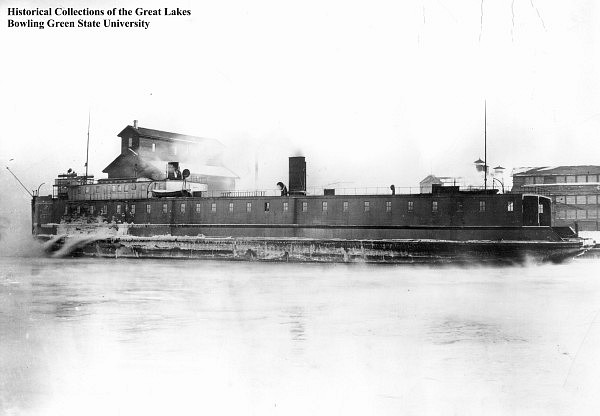
Ann Arbor No. 1, built in 1892 by Craig Shipbuilding Co. in Toledo, Ohio. She was destroyed in a fire on March 7, 1910 at Manitowoc, Wisconsin.
Photo from Bowling Green State University via Wikimedia Commons.
The Ann Arbor Railroad was as much a steamship line as a railroad. Built from Toledo, Ohio, northwest to Frankfort, Mich., it existed for one reason — to move freight in car ferries across Lake Michigan to bypass Chicago. From 1910 to 1968, “the Annie” operated 320 car ferry route-miles versus 292 miles of railroad. AA was at the forefront of car ferry design and innovation, from the first wooden-hulled vessels to the most advanced car ferry to ever sail Lake Michigan.
During the 1940s, up to six ferries made the round trip from Boat Landing, as AA called its yard in Elberta on the south side of Frankfort harbor, to two Wisconsin and two Michigan Upper Peninsula ports. The boats ran year-round on a tight schedule, timed to match with three pairs of scheduled Toledo freights, where AA interchanged with five trunk lines. Well-kept 2-8-2s powered those short, fast trains across AA’s rolling profile until 1950, when Alco FA2s took over.
[…]
The Eastern mergers of the 1960s ultimately doomed the old Ann Arbor. As planning for Penn Central went on, the Norfolk & Western merged with Wabash, Nickel Plate, and two smaller roads in 1964. N&W wanted no part of the Ann Arbor and its costly ferries, so AA was foisted off on DT&I, which was profitable by the 1960s.
With ICC approval, DT&I took over the Ann Arbor on August 31, 1963, and soon replaced the tired FA2s with 10 GP35s, riding on Alco trucks and painted in DT&I orange with large “Ann Arbor” lettering. DT&I’s GPs often mixed with the Annie’s.
DT&I had ferry Wabash refitted, changed her name to City of Green Bay, and loaned AA $2.5 million to rebuild Ann Arbor No. 7. The railroad renamed No. 7 Viking, lengthened it, installed four EMD 2,500 h.p. 567 diesels. But even with the bigger boats, capacity remained an issue as car sizes increased. AA was losing money. First the ferry route to Manistique, Mich. (and AA subsidiary Manistique & Lake Superior), was discontinued, then the one to Menominee, Mich.
Ann Arbor’s fate was sealed. A firm was hired to liquidate Pennsylvania Company assets, including AA and DT&I. Ann Arbor defaulted on the loan for the Viking on November 1, 1972, and filed for bankruptcy on October 15, 1973, leading to AA’s inclusion with other bankrupts in the Regional Rail Reorganization Act of 1973 that resulted in Conrail.
April 2, 2020
Fallen flag — the Pere Marquette Railway
This month’s fallen flag article for Classic Trains is the story of the Pere Marquette Railway by Kevin P. Keefe:
C&O’s formal acquisition of the Pere Marquette in 1947 did more than help usher in the postwar merger era; it also closed the book on a railroad with a colorful and quirky history. PM was created in 1900 by the consolidation of three roads: Flint & Pere Marquette; Detroit, Grand Rapids & Western; and Chicago & West Michigan. (The town of Pere Marquette; today we know the place as Ludington. Jacques Marquette, the French missionary and explorer, died and was buried here in 1675, and the name Pere Marquette had been given to the inlet lake off Lake Michigan, the river that feeds into it, and an 1847 community there.)
All three carriers had roots in the lumber industry, so the new Pere Marquette Railroad not only connected important Michigan cities, it also operated a branchline network covering much of the state’s Lower Peninsula. PM’s early corporate history was chaotic, marked by receivership and ownership changes. The Cincinnati, Hamilton & Dayton acquired PM in 1904 and for a time leased it to various parties, including the Erie Railroad. Thus did Baltimore & Ohio briefly control the PM through its ownership of the CH&D. When Pere Marquette came out of a receivership in 1907, it would be for only five years.
Those early, troublesome times, however, were marked by two strategic steps forward. One was the chartering of the Pere Marquette of Indiana, which built from New Buffalo, Michigan, southwest to Porter, Indiana, allowing PM to reach Chicago, via trackage rights on the Lake Shore & Michigan Southern (NYC). The second was the lease of the Lake Erie & Detroit River Railway, pushing PM eastward from Walkerville (Windsor), Ontario, to St. Thomas, thence to Suspension Bridge (Niagara Falls), New York, via rights on Michigan Central affiliate Canada Southern, and on to Buffalo on the NYC. Patched together as they were, these additions allowed PM to position itself as a Buffalo–Chicago bridge carrier.
In the ensuing years, the rectangular PM logo would largely disappear from view, although the road’s eventual 12 E7’s wore the script Pere Marquette train name, along with C&O identification, into the mid-1950s, thanks to equipment trust restrictions. PM’s three GE 70-tonners of 1947 were sold, but a few of its 16 EMD switchers (2 SW1’s of 1939 and ’42, 14 NW2’s of 1943–46) carried PM lettering into the 1960s, and C&O kept PM’s color pattern of yellow front-end bands with red pinstriping on a blue body on 11 more EMDs of 1948 that came fully lettered C&O: NW2’s 1850–1856 and E7’s 95–98.
As for the famous Berkshires, they, along with all of Pere Marquette’s steam locomotives, were retired by 1951. Eleven found a temporary reprieve on C&O’s Chesapeake District in Kentucky and West Virginia, but only for a few months. Two, 1223 and 1225, survived as display items in Michigan, and as a student at Michigan State University, I became involved with the restoration of the 1225, which today occasionally operates on excursions.
Perhaps it’s fitting that the Pere Marquette’s last equipment order as an independent railroad was in 1947 for six of EMD’s 1,500 h.p. BL2 “branchline” diesels, Nos. 80–85. Chosen to negotiate PM’s web of secondary lines — most of them rooted in the road’s origins as a logger — the homely diesels were as quirky and as singular as the PM itself. Pointedly, even though they sported the “speed striping” as found on the E7’s, the BL2’s were delivered in full “Chesapeake & Ohio” lettering.
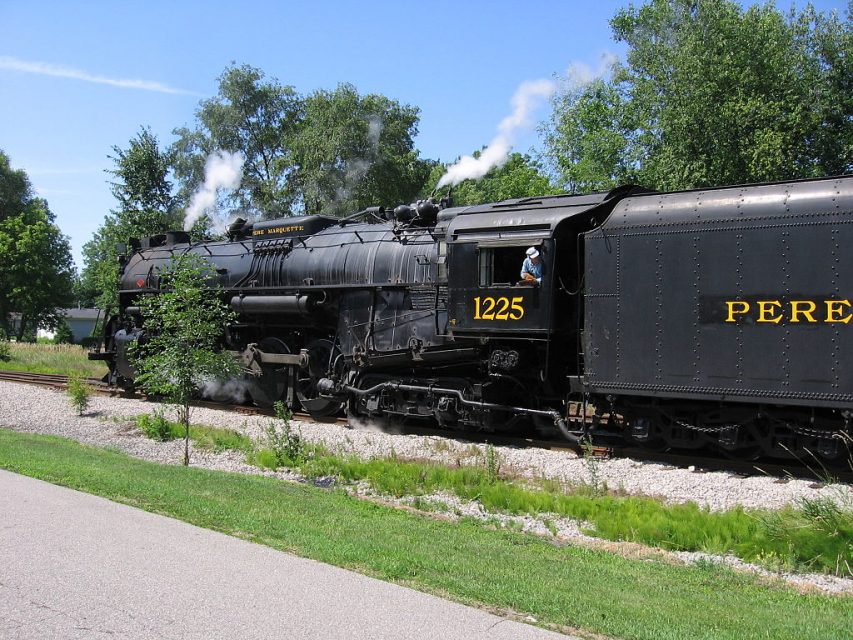
Pere Marquette 1225, a Berkshire 2-8-4 steam locomotive, passes through Alma in March 2009.
Photo by Chelseyafoster via Wikimedia Commons.
The Pere Marquette also had a maritime division and one of their ships had a disastrous voyage (via Wikipedia) 110 years ago:
The Pere Marquette operated a number of rail car ferries on the Detroit and St. Clair Rivers and on Lake Erie and Lake Michigan. The PM’s fleet of car ferries, which operated on Lake Michigan from Ludington, Michigan to Milwaukee, Kewaunee, and Manitowoc, Wisconsin, were an important transportation link avoiding the terminal and interchange delays around the southern tip of Lake Michigan and through Chicago. Their superintendent for over 30 years was William L. Mercereau.
Pere Marquette 18
On September 10, 1910, Pere Marquette 18 was bound for Milwaukee, Wisconsin, from Ludington, Michigan, with a load of 29 railroad freight cars and 62 persons. Near midnight, the vessel began to take on massive amounts of water. The captain dumped nine railroad cars into Lake Michigan, but this was no use — the ship was going down. The Pere Marquette 17, traveling nearby, picked up the distress call and sped to assist the foundering vessel. Soon after she arrived and she could come alongside, the Pere Marquette 18 sank with the loss of 28 lives; there were 33 survivors. Her wreck has yet to be located and is the largest unlocated wreck of the Great Lakes.
October 10, 2015
Police body cameras
There’s plenty of argument about whether body cams are a pro- or anti-police innovation. Here’s an example of the way body cams can actually help to show when the police are doing everything right, and things still go wrong:
We’ve written a lot here at Ars about how video surveillance has captured cops doing bad things. We cover this area because the technology of body cams, Taser cams, dash cams, and even images taken by bystanders has changed our perspective on police behavior that would likely have been swept under the rug previously.
But this surveillance technology also captures officers who, in the words of a local Cleveland county prosecutor, have acted with “remarkable restraint.” In this instance, body cam footage of several Cleveland patrol officers shows them doing everything they could to convince a man to put down his weapon.
Police came to visit Theodore Johnson’s Cleveland residence after his wife claimed he threatened to kill her. The man had already shot one officer, striking the chest of a patrolman David Muniz’s ballistic vest. “I know you shot me, but I’m not going to shoot you,” Muniz tells the 64-year-old Johnson, according to police body cam footage taken at the scene.
To be honest, I’m quite impressed at the restraint these officers managed to show. If a member of my team had just been shot, I know it’d be very tough for me not to return fire…
September 13, 2014
Ohio State University’s bureaucratic approach to student-to-student intimacy
US colleges and universities are struggling to come up with new and innovative ways of regulating how their students interact in intimate situations. Ohio State University, for example, now requires that students who engage in sexual relations must agree on why they want to have sex to avoid the risk of sexual assault charges being brought:
At Ohio State University, to avoid being guilty of “sexual assault” or “sexual violence,” you and your partner now apparently have to agree on the reason WHY you are making out or having sex. It’s not enough to agree to DO it, you have to agree on WHY: there has to be agreement “regarding the who, what, where, when, why, and how this sexual activity will take place.”
There used to be a joke that women need a reason to have sex, while men only need a place. Does this policy reflect that juvenile mindset? Such a requirement baffles some women in the real world: a female member of the U.S. Commission on Civil Rights told me, “I am still trying to wrap my mind around the idea of any two intimates in the world agreeing as to ‘why.’”
Ohio State’s sexual-assault policy, which effectively turns some welcome touching into “sexual assault,” may be the product of its recent Resolution Agreement with the Office for Civil Rights (where I used to work) to resolve a Title IX complaint over its procedures for handling cases of sexual harassment and assault. That agreement, on page 6, requires the University to “provide consistent definitions of and guidance about the University terms ‘sexual harassment,’ ‘consent,’ ‘sexual violence,’ ‘sexual assault,’ and ‘sexual misconduct.’” It is possible that Ohio State will broaden its already overbroad “sexual assault” definition even further: Some officials at Ohio State, like its Student Wellness Center, advocate defining all sex or “kissing” without “verbal,” “enthusiastic” consent as “sexual assault.”
Ohio State applies an impractical “agreement” requirement to not just sex, but also to a much broader category of “touching” that is sexual (or perhaps romantic?) in nature. First, it states that “sexual assault is any form of non-consensual sexual activity. Sexual assault includes all unwanted sexual acts from intimidation to touching to various forms of penetration and rape.” Then, it states that “Consent is a knowing and voluntary verbal or non-verbal agreement between both parties to participate in each and every sexual act … Conduct will be considered “non-consensual” if no clear consent … is given … Effective consent can be given by words or actions so long as the words or actions create a mutual understanding between both parties regarding the conditions of the sexual activity–ask, ‘do both of us understand and agree regarding the who, what, where, when, why, and how this sexual activity will take place?’”
Update:
Advice to college guys: avoid all college women. If you want to have sex, go to a prostitute and get a receipt. http://t.co/sh9voKuJ9L
— David Burge (@iowahawkblog) September 13, 2014
September 10, 2014
Ohio Amish Barn Raising – May 13th, 2014 in 3 Minutes and 30 seconds
Published on 14 May 2014
My husband, Scott Miller, shot this video with a Canon 60d Camera using a Pixel TW-282/E3 Wireless remote timer set at 20 second intervals. He shot 1600 pictures from 7:00am until 5:00pm and compressed the 10 hours into 3 minutes and 30 seconds. He even took the day off work to help :). The music in this video was found on the free YouTube music library. It is a song called Cruisin’, by Scott Vestal, off of the compilation album, Bluegrass ’95. To use this video in a commercial player or in broadcasts, please email licensing@storyful.com
May 7, 2013
Cleveland in the news
Dave Owens sent this along, saying “It may be the greatest TV interview ever.”
April 5, 2013
What to do when the law is wrong
J.D. Tuccille explains why he’s teaching his son to break the law:
In 1858, hundreds of residents of Oberlin and Wellington, Ohio — many of them students and faculty at Oberlin College — surrounded Wadsworth’s Hotel, in Wellington, in which law enforcement officers and slavehunters held a fugitive slave named John Price, under the authority of the Fugitive Slave Act. After a brief standoff, the armed crowd stormed the hotel and overpowered the captors. Price was freed and transported to safety in Canada [. . .] I know these details because my son recently borrowed from the library The Price of Freedom, a book about the Oberlin-Wellington Rescue, as the incident is called (PDF). My wife and I used it as a starting point for telling our seven-year-old why we don’t expect him to obey the law — that laws and the governments that pass them are often evil. We expect him, instead, to stand up for his rights and those of others, and to do good, even if that means breaking the law.
Our insistence on putting right before the law isn’t a new position. I’ve always liked Ralph Waldo Emerson’s sentiment that “Good men must not obey the laws too well.” That’s a well-known quote, but it comes from a longer essay in which he wrote:
Republics abound in young civilians, who believe that the laws make the city, that grave modifications of the policy and modes of living, and employments of the population, that commerce, education, and religion, may be voted in or out; and that any measure, though it were absurd, may be imposed on a people, if only you can get sufficient voices to make it a law. But the wise know that foolish legislation is a rope of sand, which perishes in the twisting …
Rope of sand the law may be, but it can strangle unlucky people on the receiving end long before it perishes. John Price could well have ended up with not just the law, but a real rope, around his neck, just because he wanted to exercise the natural freedom to which he was entitled by birth as a sapient being.
John Price ended his life as a free man because he was willing to defy laws that said he was nothing but the property of other people, to be disposed of as they wished. He got a nice helping hand in maintaining his freedom from other people who were willing to not only defy laws that would compel them to collaborate in Price’s bondage, but to beat the hell out of government agents charged with enforcing those laws.
September 10, 2011
NFL quote of the day
At the Daily Norseman, Eric J. Thompson puts the awful situation for both Ohio NFL teams in perfect perspective:
BROWNS over Bengals: Can we just have Ohio State replace one of these two teams already? Or would the Buckeyes’ salary put them over the cap?
I’m not a great prognosticator (I’m already 0-1 on the season — the Saints let me down against the hated Packers), so you can take these picks for exactly what they’re worth (i.e., very little):
- Atlanta – @Chicago Sun 1:00pm
- @Cleveland – Cincinnati Sun 1:00pm
- @Kansas City – Buffalo Sun 1:00pm
- Philadelphia – @St. Louis Sun 1:00pm
- @Tampa Bay – Detroit Sun 1:00pm
- @Jacksonville – Tennessee Sun 1:00pm
- @Baltimore – Pittsburgh Sun 1:00pm
- @Houston – Indianapolis Sun 1:00pm
- @Arizona – Carolina Sun 4:15pm
- @San Diego – Minnesota Sun 4:15pm
- @San Francisco – Seattle Sun 4:15pm
- New York (NYG) – @Washington Sun 4:15pm
- @New York (NYJ) – Dallas Sun 8:20pm
- New England – @Miami Mon 7:00pm
- @Denver – Oakland – Mon 10:15pm
Favourites listed first, home team marked with “@”.

